Ice Detection with Sentinel-1 SAR Backscatter Threshold in Long Sections of Temperate Climate Rivers
Abstract
:1. Introduction
2. Materials and Methods
2.1. Study Area
2.2. Model Development and Validation
2.3. Satellite Data
3. Results
3.1. Backscatter from Ice and Open Water
3.2. Logistic Classification Model
3.3. Classification Threshold
3.4. Model Validation
3.4.1. Translucent Clouds and Cloud Shadow
3.4.2. Effect of Reservoir and River Valley Shadows
3.4.3. Water on Ice
3.4.4. Frazil and Consolidated Ice
4. Discussion
5. Conclusions
Author Contributions
Funding
Institutional Review Board Statement
Informed Consent Statement
Data Availability Statement
Conflicts of Interest
References
- Newton, A.M.W.; Mullan, D.J. Climate change and Northern Hemisphere lake and river ice phenology from 1931–2005. Cryosphere 2021, 15, 2211–2234. [Google Scholar] [CrossRef]
- Yang, X.; Pavelsky, T.M.; Allen, G.H. The past and future of global river ice. Nature 2020, 577, 69–73. [Google Scholar] [CrossRef] [PubMed]
- Stonevicius, E.; Stankunavicius, G.; Kilkus, K. Ice regime dynamics in the Nemunas River, Lithuania. Clim. Res. 2008, 36, 17–28. [Google Scholar] [CrossRef] [Green Version]
- Knoll, L.B.; Sharma, S.; Denfeld, B.A.; Flaim, G.; Hori, Y.; Magnuson, J.J.; Straile, D.; Weyhenmeyer, G.A. Consequences of lake and river ice loss on cultural ecosystem services. Limnol. Oceanogr. Lett. 2019, 4, 119–131. [Google Scholar] [CrossRef] [Green Version]
- Gauthier, Y.; Weber, F.; Savary, S.; Jasek, M. A combined classification scheme to characterise. EARSeL Eproc. 2006, 5, 77–88. [Google Scholar]
- Duguay, C.R.; Bernier, M.; Gauthier, Y.; Kouraev, A. Remote Sensing of Lake and River Ice; Wiley: Hoboken, NJ, USA, 2014; ISBN 9781118368909. [Google Scholar]
- Turcotte, B.; Morse, B. A global river ice classification model. J. Hydrol. 2013, 507, 134–148. [Google Scholar] [CrossRef]
- Łoś, H.; Osińska-Skotak, K.; Pluto-Kossakowska, J.; Bernier, M.; Gauthier, Y.; Pawłowski, B. Performance evaluation of quad-pol data compare to dual-pol SAR data for river ice classification. Eur. J. Remote Sens. 2019, 52, 79–95. [Google Scholar] [CrossRef] [Green Version]
- Chu, T.; Das, A.; Lindenschmidt, K.E. Monitoring the variation in ice-cover characteristics of the Slave River, Canada using RADARSAT-2 Data-A case study. Remote Sens. 2015, 7, 13664–13691. [Google Scholar] [CrossRef] [Green Version]
- Gauthier, Y.; Tremblay, M.; Bernier, M.; Furgal, C. Adaptation of a radar-based river ice mapping technology to the Nunavik context. Can. J. Remote Sens. 2010, 36, S168–S185. [Google Scholar] [CrossRef]
- Lindenschmidt, K.E. Characterising river ice along the Lower Red River using RADARSAT-2 imagery. In Proceedings of the 16th Workshop on River Ice, Winnipeg, MB, Canada, 8–11 September 2011; pp. 1–16. [Google Scholar]
- Surdu, C.M.; Duguay, C.R.; Pour, H.K.; Brown, L.C. Ice freeze-up and break-up detection of shallow lakes in Northern Alaska with spaceborne SAR. Remote Sens. 2015, 7, 6133–6159. [Google Scholar] [CrossRef] [Green Version]
- Jasek, M.; Gauthier, Y.; Poulin, J.; Bernier, M. Monitoring of freeze-up on the Peace River at the Vermilion Rapids using RADARSAT-2 SAR data. In Proceedings of the 17th Workshop on River Ice, Edmonton, AB, Canada, 21–24 July 2013; pp. 229–257. [Google Scholar]
- Gherboudj, I.; Bernier, M.; Leconte, R. A backscatter modeling for river ice: Analysis and numerical results. IEEE Trans. Geosci. Remote Sens. 2010, 48, 1788–1798. [Google Scholar] [CrossRef]
- Mermoz, S.; Allain-Bailhache, S.; Bernier, M.; Pottier, E.; Van Der Sanden, J.J.; Chokmani, K. Retrieval of river ice thickness from C-band PolSAR data. IEEE Trans. Geosci. Remote Sens. 2014, 52, 3052–3062. [Google Scholar] [CrossRef] [Green Version]
- Los, H.; Pawlowski, B. The use of Sentinel-1 imagery in the analysis of river ice phenomena on the lower Vistula in the 2015–2016 winter season. In Proceedings of the 2017 Signal Processing Symposium (SPSympo), Debe, Poland, 12–14 September 2017; p. 4. [Google Scholar] [CrossRef]
- Drouin, H.; Gauthier, Y.; Bernier, M.; Jasek, M.; Penner, O.; Weber, F. Quantitative validation of RADARSAT-1 river ice maps. In Proceedings of the 14th Workshop of the Committee on River Ice Processes and the Environment, Quebec City, QC, Canada, 19–22 June 2007; p. 18. [Google Scholar]
- Nagler, T.; Rott, H.; Ripper, E.; Bippus, G.; Hetzenecker, M. Advancements for snowmelt monitoring by means of Sentinel-1 SAR. Remote Sens. 2016, 8, 348. [Google Scholar] [CrossRef] [Green Version]
- Zubaničs, A. River ice detection on The Daugava River using Sentinel-1 SAR data. In Proceedings of the 100th AMS Annual Meeting, Boston, MA, USA, 12–16 January 2019; p. 1. [Google Scholar]
- Pantea, G.; Lacusteanu, A. Monitoring of the freezing Danube delta based on Sentinel-1/2 imagery. J. Young Sci. 2017, 5, 213–218. [Google Scholar]
- De Roda Husman, S.; van der Sanden, J.J.; Lhermitte, S.; Eleveld, M.A. Integrating intensity and context for improved supervised river ice classification from dual-pol Sentinel-1 SAR data. Int. J. Appl. Earth Obs. Geoinf. 2021, 101, 102359. [Google Scholar] [CrossRef]
- Ning, L.; Xie, F.; Gu, W.; Xu, Y.; Huang, S.; Yuan, S.; Cui, W.; Levy, J. Using remote sensing to estimate sea ice thickness in the Bohai Sea, China based on ice type. Int. J. Remote Sens. 2009, 30, 4539–4552. [Google Scholar] [CrossRef]
- Tom, M.; Prabha, R.; Wu, T.; Baltsavias, E.; Leal-Taixé, L.; Schindler, K. Ice monitoring in Swiss lakes from optical satellites and webcams using machine learning. Remote Sens. 2020, 12, 3555. [Google Scholar] [CrossRef]
- Kraatz, S.; Khanbilvardi, R.; Romanov, P. River ice monitoring with MODIS: Application over Lower Susquehanna River. Cold Reg. Sci. Technol. 2016, 131, 116–128. [Google Scholar] [CrossRef]
- Chaouch, N.; Temimi, M.; Romanov, P.; Cabrera, R.; Mckillop, G.; Khanbilvardi, R. An automated algorithm for river ice monitoring over the Susquehanna River using the MODIS data. Hydrol. Process. 2014, 28, 62–73. [Google Scholar] [CrossRef]
- Beaton, A.; Whaley, R.; Corston, K.; Kenny, F. Identifying historic river ice breakup timing using MODIS and Google Earth Engine in support of operational flood monitoring in Northern Ontario. Remote Sens. Environ. 2019, 224, 352–364. [Google Scholar] [CrossRef]
- Li, H.; Li, H.; Wang, J.; Hao, X. Monitoring high-altitude river ice distribution at the basin scale in the northeastern Tibetan Plateau from a Landsat time-series spanning 1999–2018. Remote Sens. Environ. 2020, 247, 111915. [Google Scholar] [CrossRef]
- Selkowitz, D.J.; Forster, R.R. An automated approach for mapping persistent ice and snow cover over high latitude regions. Remote Sens. 2016, 8, 16. [Google Scholar] [CrossRef] [Green Version]
- Prabha, R.; Tom, M.; Rothermel, M.; Baltsavias, E.; Leal-Taixe, L.; Schindler, K. Lake ice monitoring with webcams and crowd-sourced images. arXiv 2020, arXiv:2002.07875. [Google Scholar] [CrossRef]
- HR-S&I Consortium. Pan-European High-Resolution Snow & Ice Monitoring of the Copernicus Land Monitoring Service—Production of Basic Products Quality Assessment Report for Ice Products Based on Sentinel-2. 2021. Available online: https://land.copernicus.eu/user-corner/technical-library/hrsi-ice-atbd (accessed on 24 March 2022).
- Lindenschmidt, K.-E.; Li, Z. Monitoring river ice cover development using the Freeman–Durden decomposition of quad-pol Radarsat-2 images. J. Appl. Remote Sens. 2018, 12, 026014. [Google Scholar] [CrossRef]
- SNAP. Available online: https://step.esa.int/main/toolboxes/snap/ (accessed on 24 March 2022).
- Main-Knorn, M.; Pflug, B.; Louis, J.; Debaecker, V.; Müller-Wilm, U.; Gascon, F. Sen2Cor for Sentinel-2. In Proceedings of the SPIE 2017, 10427, Image and Signal Processing for Remote Sensing XXIII, Bellingham, DC, USA, 11–13 September 2018. [Google Scholar] [CrossRef] [Green Version]
- HR-S&I Consortium. Pan-European High-Resolution Snow & Ice Monitoring Of The Copernicus Land Monitoring Service Algorithm Theoretical Basis Document For Ice Products Based On Sentinel-1 & Sentinel-2. 2021. Available online: https://land.copernicus.eu/user-corner/technical-library/hrsi-ice-s1-atbd/ (accessed on 24 March 2022).
- DeLancey, E.R.; Kariyeva, J.; Cranston, J.; Brisco, B. Monitoring hydro temporal variability in Alberta, Canada with multi-temporal sentinel-1 SAR data. Can. J. Remote Sens. 2018, 44, 1–10. [Google Scholar] [CrossRef]
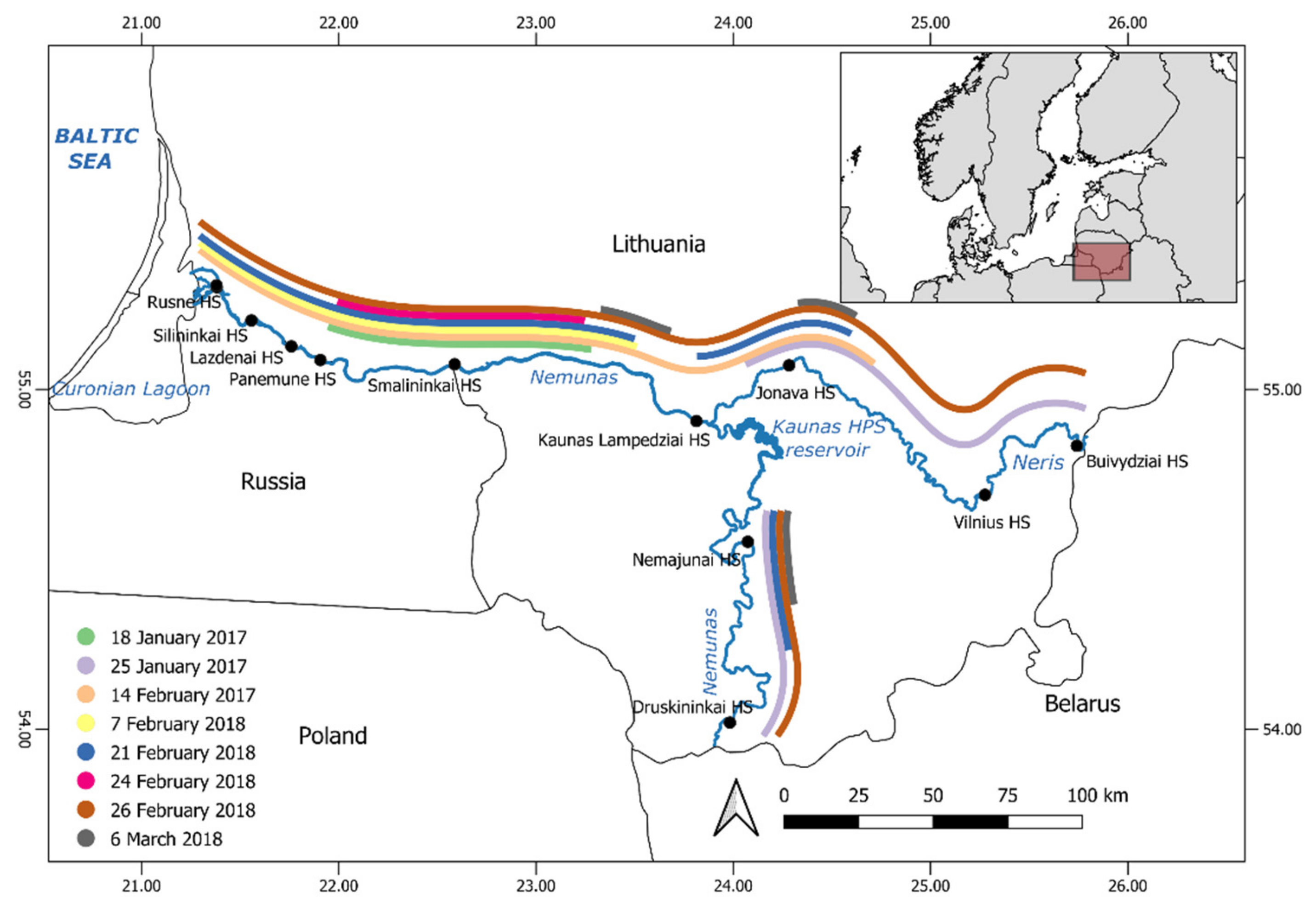
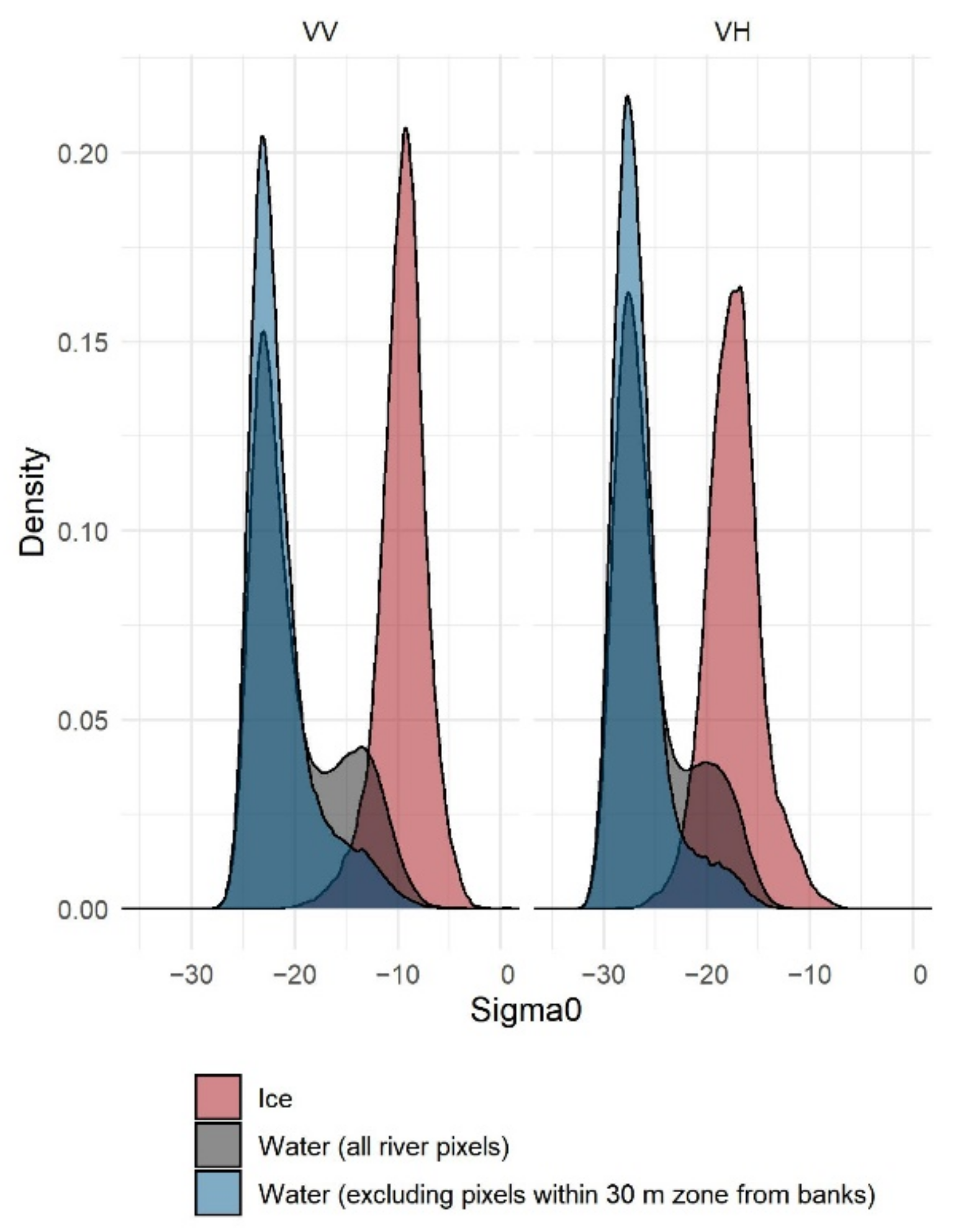
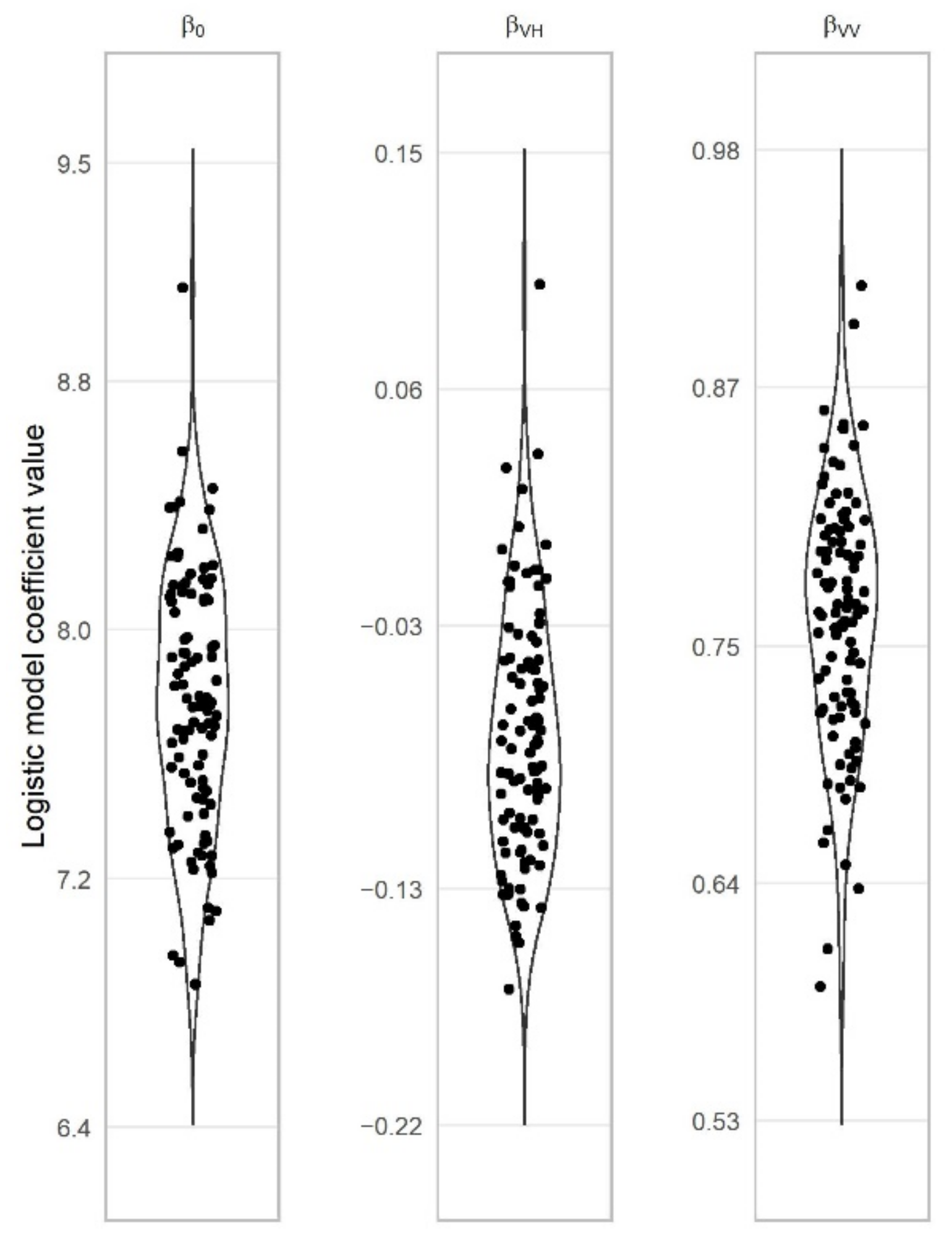
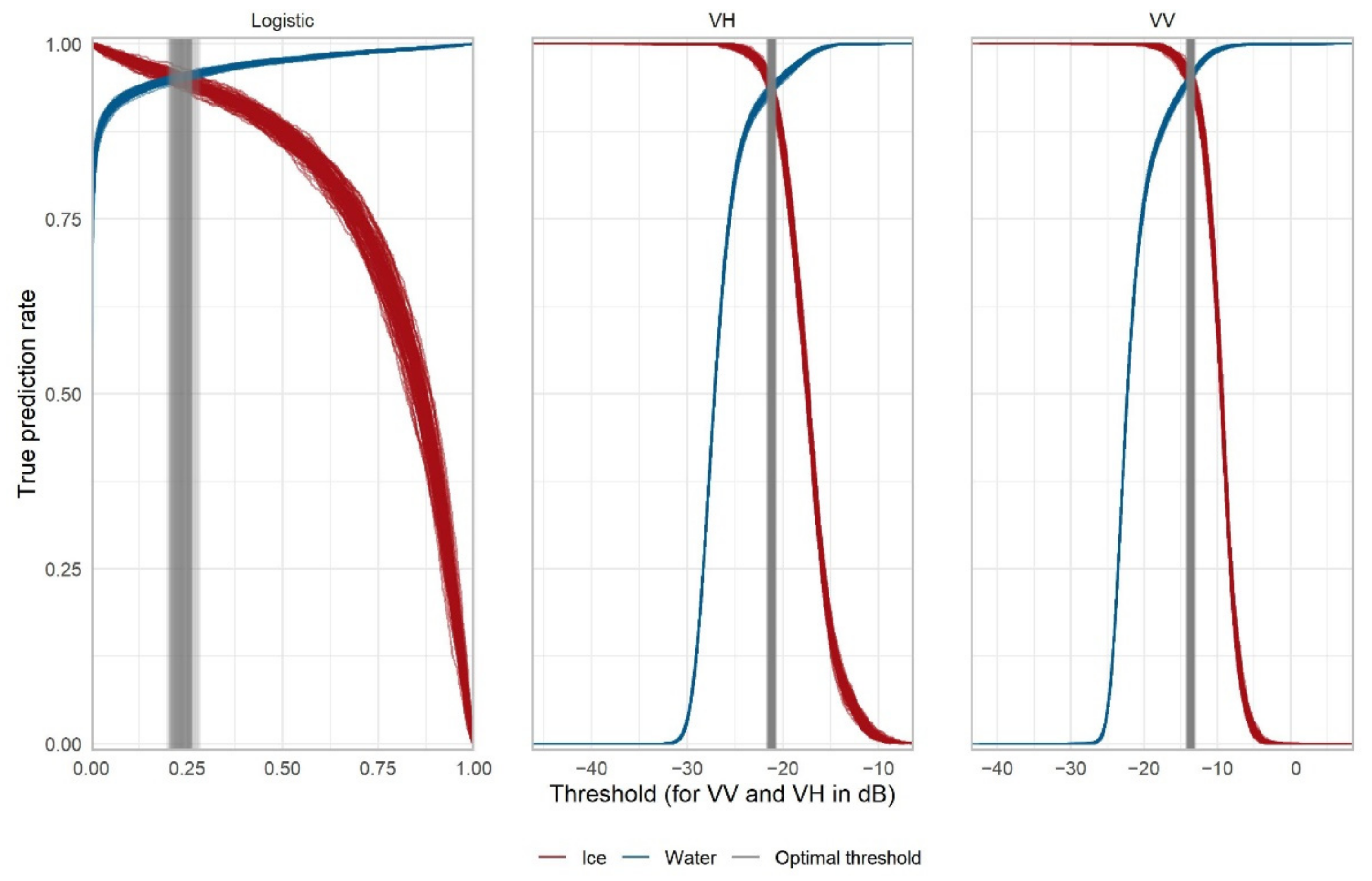
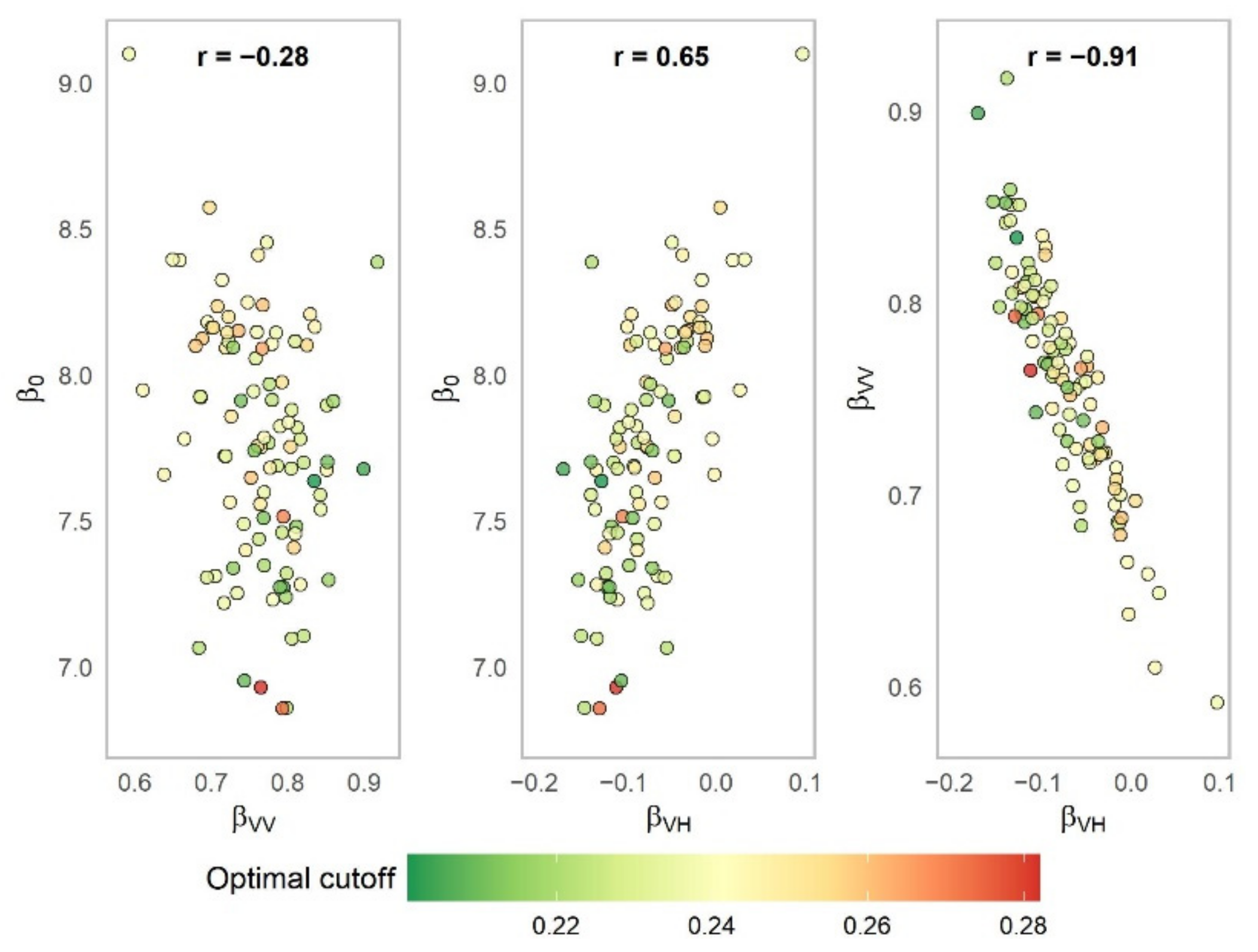
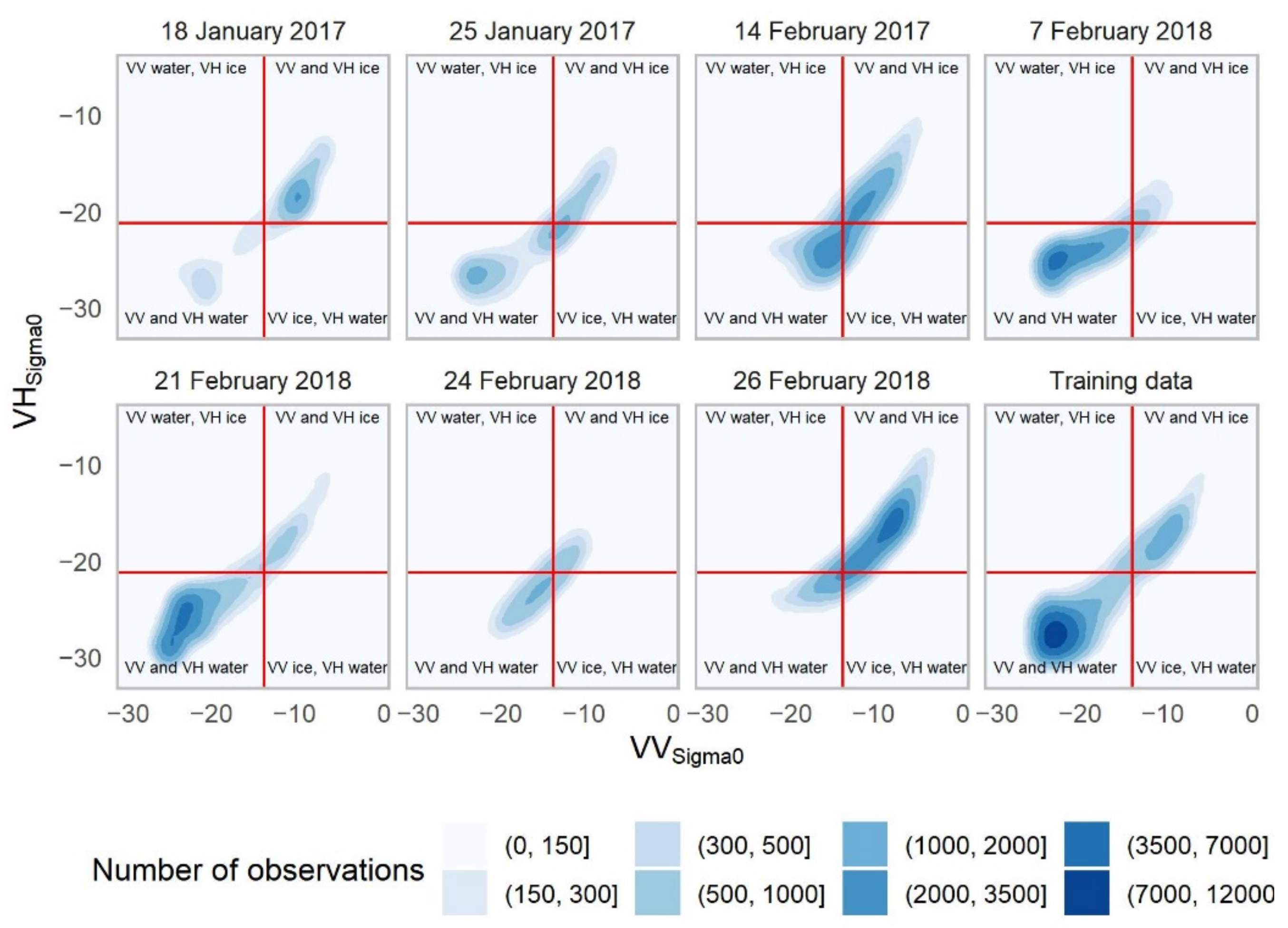
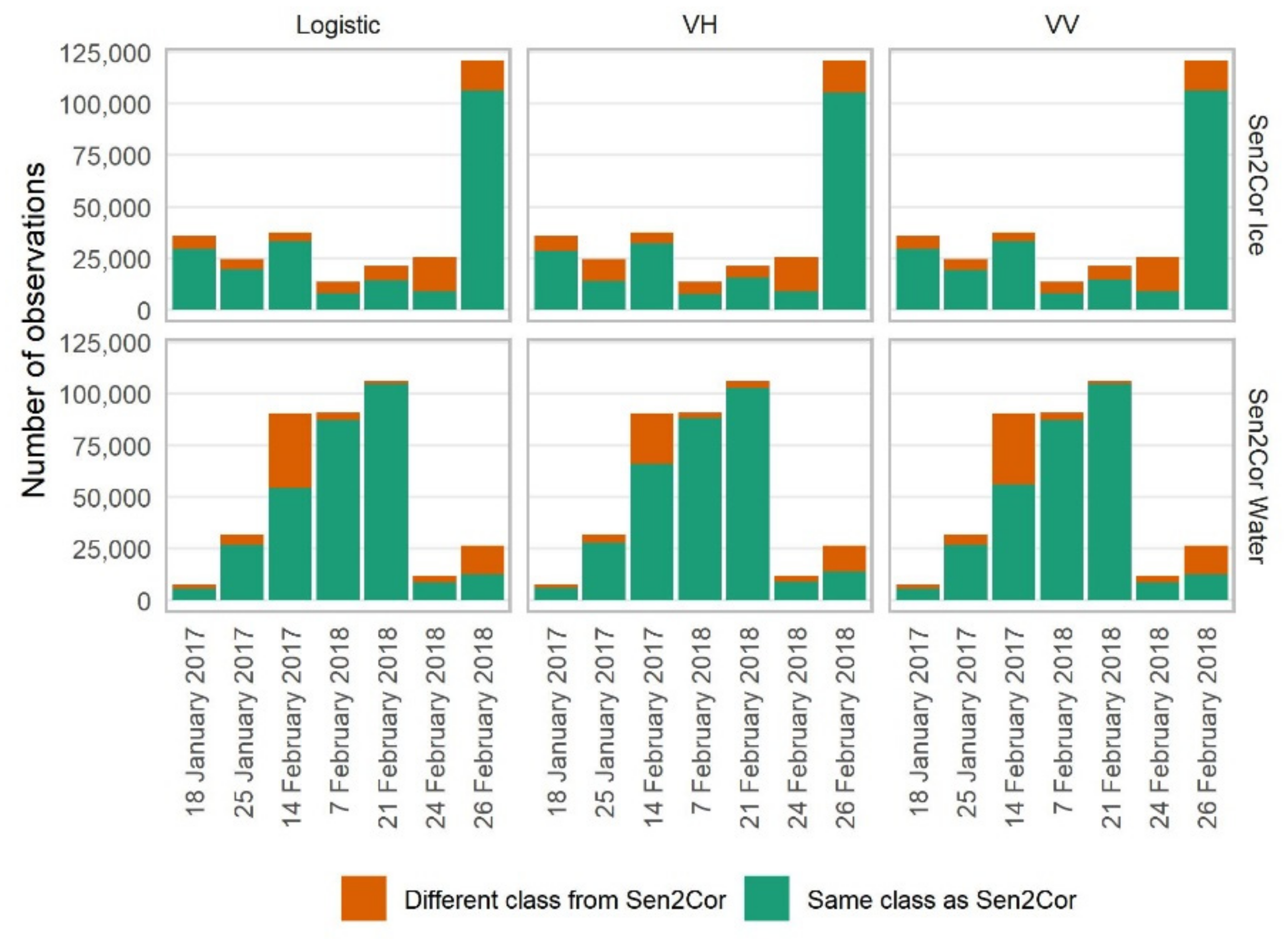

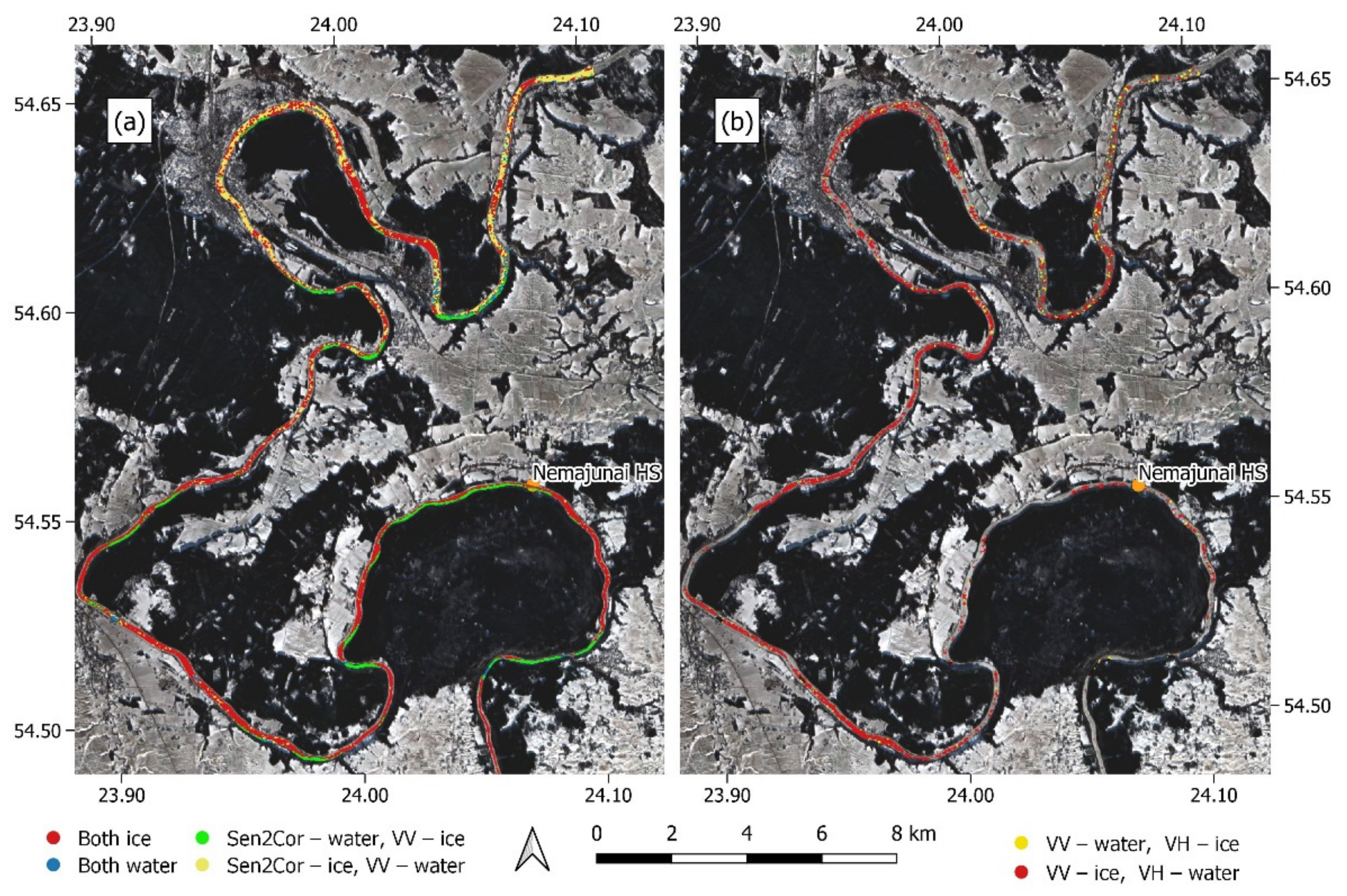

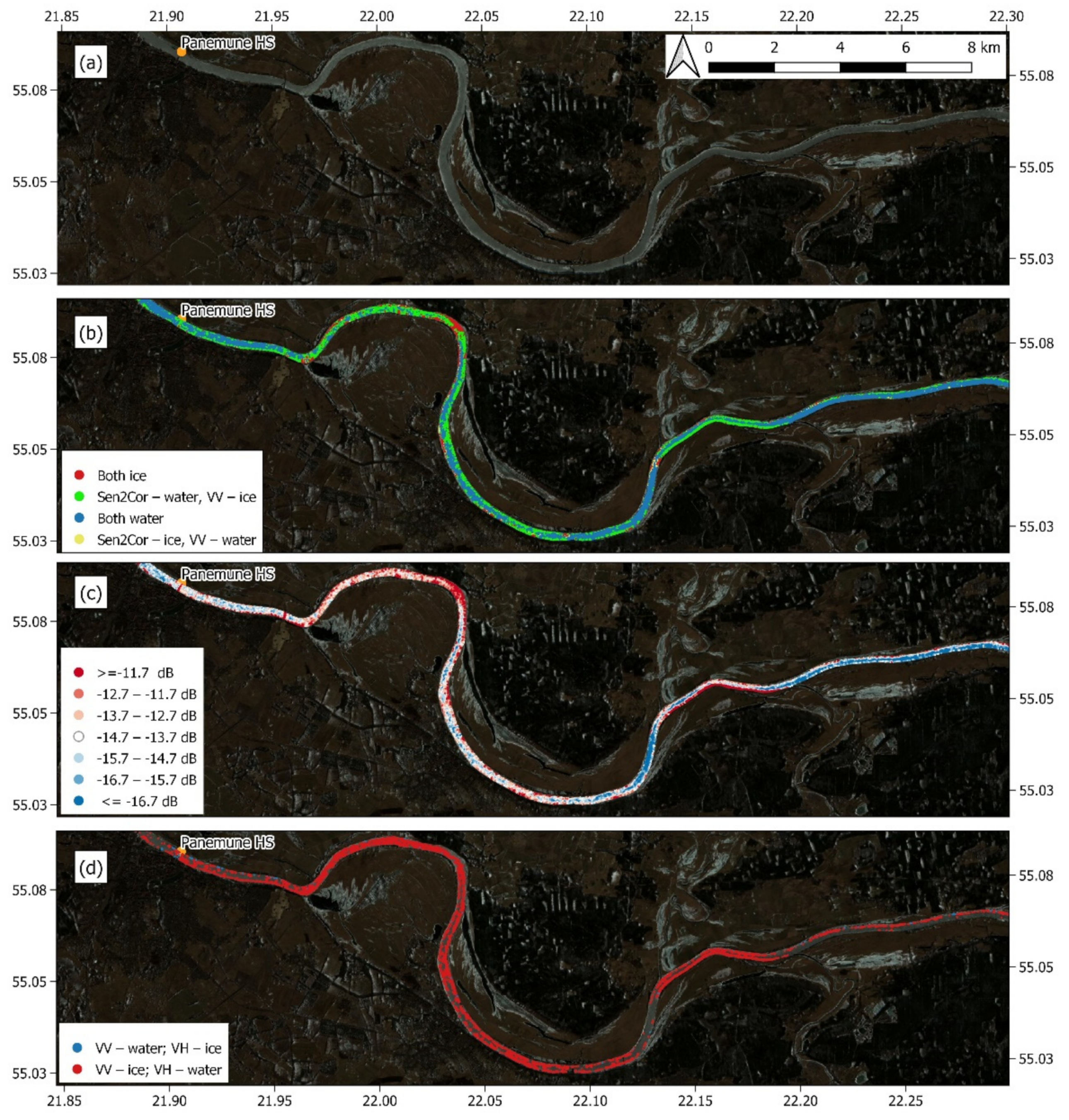
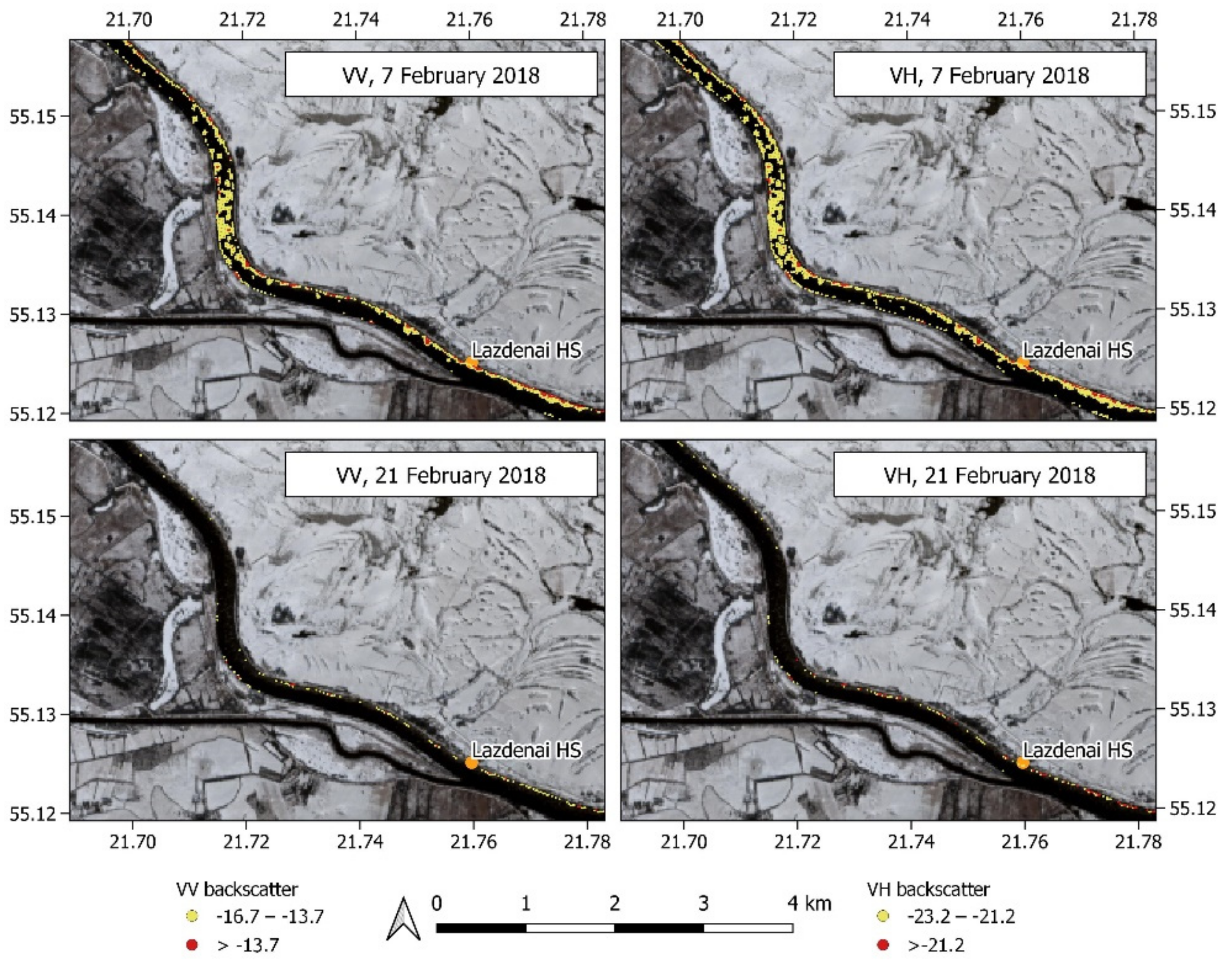
| Sentinel-1 SAR IW GRD High Resolution | Sentinel-2 MSI L1C | Dataset | ||||
|---|---|---|---|---|---|---|
| Acquisition Date | Acquisition Time | Satellite | Orbit Direction | Relative Orbit | Acquisition Time | |
| 18 January 2017 | 16:19 | S1B | Ascending | 29 | 09:53 | Testing |
| 25 January 2017 | 16:10 | S1B | Ascending | 131 | 09:42 | |
| 14 February 2017 | 04:43 | S1A | Descending | 153 | 09:41 | |
| 7 February 2018 | 16:11 | S1A | Ascending | 131 | 09:51 | |
| 21 February 2018 | 04:43 | S1A | Descending | 153 | 09:30 | |
| 09:50 (22 February 2018) | ||||||
| 24 February 2018 | 16:19 | S1A | Ascending | 29 | 09:40 | |
| 26 February 2018 | 04:51 | S1A | Descending | 51 | 09:30 | |
| 16:03 | S1A | Ascending | 58 | 09:50 (27 February 2018) | ||
| 6 March 2018 | 04:34 | S1B | Descending | 80 | 09:40:19 | Training |
| 10 May 2018 | 04:42 | S1B | Descending | 153 | ||
| 13 May 2018 | 16:19 | S1B | Ascending | 29 | ||
| 3 November 2018 | 16:20 | S1A | Ascending | 29 | ||
| 6 November 2018 | 04:42 | S1B | Descending | 153 | ||
| Model | Equation |
|---|---|
| VV | water 0 = VVSigma0 < −13.7 dB ice = VVSigma0 ≥ −13.7 dB |
| VH | water = VHSigma0 < −21.2 dB ice = VHSigma0 ≥ −21.2 dB |
| Logistic | ice = 7.8 + 0.76 × VVSigma0 − 0.07 × VHSigma0 < 0.24 water = 7.8 + 0.76 × VVSigma0 − 0.07 × VHSigma0 ≥ 0.24 |
| Date | VV with Sen2Cor | VH with Sen2Cor | Logistic with Sen2Cor | Logistic with VV | Logistic with VH | VH with VV |
|---|---|---|---|---|---|---|
| 18 January 2017 | 80.5 | 79.1 | 80.5 | 99.6 | 93.3 | 93.6 |
| 25 January 2017 | 81.7 | 73.8 | 82.2 | 99.0 | 84.8 | 85.8 |
| 14 February 2017 | 69.9 | 76.7 | 68.4 | 97.8 | 80.8 | 83.1 |
| 7 February 2018 | 91.2 | 91.5 | 91.0 | 99.6 | 94.1 | 94.5 |
| 21 February 2018 | 93.6 | 93.1 | 93.5 | 99.7 | 96.1 | 96.4 |
| 24 February 2018 | 46.7 | 47.6 | 46.6 | 98.6 | 83.0 | 84.4 |
| 26 February 2018 | 80.9 | 80.4 | 80.8 | 99.4 | 90.0 | 90.6 |
| Training data | 95.2 | 93.7 | 95.4 | 99.7 | 96.7 | 97.0 |
Publisher’s Note: MDPI stays neutral with regard to jurisdictional claims in published maps and institutional affiliations. |
© 2022 by the authors. Licensee MDPI, Basel, Switzerland. This article is an open access article distributed under the terms and conditions of the Creative Commons Attribution (CC BY) license (https://creativecommons.org/licenses/by/4.0/).
Share and Cite
Stonevicius, E.; Uselis, G.; Grendaite, D. Ice Detection with Sentinel-1 SAR Backscatter Threshold in Long Sections of Temperate Climate Rivers. Remote Sens. 2022, 14, 1627. https://doi.org/10.3390/rs14071627
Stonevicius E, Uselis G, Grendaite D. Ice Detection with Sentinel-1 SAR Backscatter Threshold in Long Sections of Temperate Climate Rivers. Remote Sensing. 2022; 14(7):1627. https://doi.org/10.3390/rs14071627
Chicago/Turabian StyleStonevicius, Edvinas, Giedrius Uselis, and Dalia Grendaite. 2022. "Ice Detection with Sentinel-1 SAR Backscatter Threshold in Long Sections of Temperate Climate Rivers" Remote Sensing 14, no. 7: 1627. https://doi.org/10.3390/rs14071627






